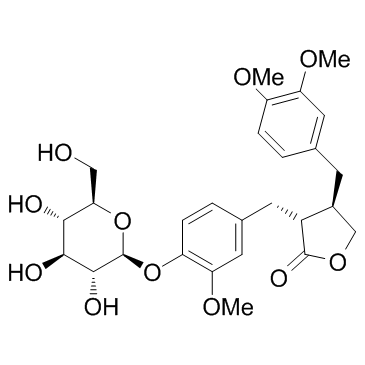20362-31-6
| Name | Arctiin |
|---|---|
| Synonyms |
MFCD00870630
Arctiin (8CI) 4-{[(3R,4R)-4-(3,4-Dimethoxybenzyl)-2-oxotetrahydro-3-furanyl]methyl}-2-methoxyphenyl β-D-glucopyranoside Arctigenin-4-glucoside Arctin Arctlin 2(3H)-Furanone, 4-[(3,4-dimethoxyphenyl)methyl]-3-[[4-(b-D-glucopyranosyloxy)-3-methoxyphenyl]methyl]dihydro-, (3R,4R)- Arctiin 4-{[(3R,4R)-4-(3,4-Dimethoxybenzyl)-2-oxotetrahydrofuran-3-yl]methyl}-2-methoxyphenyl β-D-glucopyranoside 2(3H)-Furanone, 4-[(3,4-dimethoxyphenyl)methyl]-3-[[4-(β-D-glucopyranosyloxy)-3-methoxyphenyl]methyl]dihydro-, (3R,4R)- Great Burdock Root Extract NSC 315527 Acrctiin |
| Description | Arctiin(NSC 315527), a plant lignan that can be extracted from the Arctium lappa (burdock) seeds, is a possible environmental endocrine disruptor compounds and have been shown to influence sex hormone metabolism as well as protein synthesis, steroid biosynthesis. IC50 Value:Target: Othersin vitro: Treatment of PC-3 cells with arctiin decreased the cell number in a concentration- and time-dependent manner in serum-containing condition. Arctiin preferentially induced cell detachment, but did not have anti-proliferation or cytotoxic effects in PC-3 cells. The arctiin-induced effect was inhibited by cycloheximide, indicating that protein synthesis was required [1]. Although arctiin, the active component of AL that has been described in the literature, was not able to reduce degranulation in RBL-2H3 cells, a single high-performance liquid chromatography (HPLC) fraction from the AL extract inhibited beta-hexosaminidase release (IC(50) = 22.2 microg/ml) [2]. The growth inhibition caused by arctiin is associated with the down-regulation of cyclin D1 protein expression. Furthermore, thearctiin-induced suppression of cyclin D1 protein expression occurs in various types of human tumor cells, including osteosarcoma, lung, colorectal, cervical and breast cancer, melanoma, transformed renal cells and prostate cancer. Depletion of the cyclin D1 protein using small interfering RNA-rendered human breast cancer MCF-7 cells insensitive to the growth inhibitory effects of arctiin, implicates cyclin D1 as an important target of arctiin [6]. in vivo: Histopathological evaluation of prostate revealed that all the rats in any group developed adenocarcinoma in dorsolateral lobe of prostate, except two rats in 0.1% arctiin treated and one rat in 0.002% arctiin treated groups without prostate adenocarcinoma development [3]. After oral administration of arctiin (30, 60, 120 mg/kgd) for three weeks, the levels of serum creatinine (Scr) and blood urea nitrogen (BUN) and 24-h urine protein content markedly decreased, while endogenous creatinine clearance rate (ECcr) significantly increased [4]. STZ-induced diabetic rats were treated witharctiin at the dosage of 60 or 40 mg/kg/day via intraperitoneal injection for 8 weeks. Blood glucose and 24-h urinary albumin content were measured, and kidney histopathological changes were monitored [5]. |
|---|---|
| Related Catalog | |
| References |
| Density | 1.4±0.1 g/cm3 |
|---|---|
| Boiling Point | 756.4±60.0 °C at 760 mmHg |
| Melting Point | 109 °C |
| Molecular Formula | C27H34O11 |
| Molecular Weight | 534.552 |
| Flash Point | 250.1±26.4 °C |
| Exact Mass | 534.210083 |
| PSA | 153.37000 |
| LogP | 0.23 |
| Vapour Pressure | 0.0±2.7 mmHg at 25°C |
| Index of Refraction | 1.601 |
| Storage condition | ?20°C |
| RIDADR | NONH for all modes of transport |
|---|

